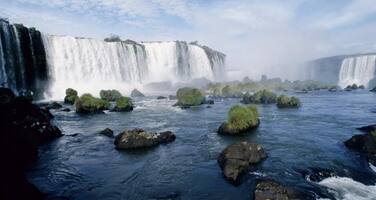Iguaçu National Park
Factors affecting the property in 1992*
- Impacts of tourism / visitor / recreation
- Input of excess energy
Factors* affecting the property identified in previous reports
Administration of the falls (Argentina); Sound pollution (helicopters)
International Assistance: requests for the property until 1992
Total amount approved : 0 USD
Missions to the property until 1992**
Conservation issues presented to the World Heritage Committee in 1992
Summary of the interventions
Decisions adopted by the Committee in 1992
16 BUR V.13
Iguazu National Park (Argentina) and Iguacu National Park (Brazil)
The Bureau recalled that the Committee, at its last session, had noted that eight helicopters simultaneously overflew the waterfall area and that local conservation groups opposed the use of the area by helicopters since it contravened legal regulations for air traffic over protected areas. At its last session, the Committee was informed that the Brazilian authorities had established a group to study the matter and had requested the Secretariat to contact the Argentine authorities to obtain lir information on the steps taken by them. The Brazilian authorities have, by their letter of 5 June 1992, indicated that the Working Group had considered the positive (economic benefits to local people) and negative (noise pollution) aspects of helicopter tourism and had identified potential mechanisms (regulation of number of visits, time-table of visits, maximum level of noise permitted for helicopter traffic in the area, taxing helicopter operators for using the National Park area) for regulation and control. However, the Group had concluded that at present the negative impacts do not override the positive effects and had recommended that the situation be further monitored before any regulatory measures are introduced.
The Argentine authorities, by their letter of 17 June 1992, provided information on the joint efforts of their National Park Administration and Air Force to establish an agreement to regulate use of the air space over the Iguazu National Park by helicopters. Until such time as an agreement will be drafted and finalized, the existing norms for use of air space between surface level and an altitude of 112 km will be strictly enforced. Violation of these regulations by an helicopter operator is punishable by cancellation, for six months, of the permit to use the National Park area.
The Bureau noted the views of, and the steps taken by the two States Parties concerned to regulate helicopter use of the air space over the waterfall area and requested IUCN and the World Heritage Centre to continue to monitor the problem and its management by the authorities responsible for the two National Parks.
16 COM VIII.12
State of Conservation of 3 Properties and Revised Boundaries of Dinosaur Provincial Park (Canada)
VIII.12 The Committee decided to register the report and the map provided by the Canadian authorities as a description of the revised boundaries of the Dinosaur Provincial Park (Canada). The Committee expressed satisfaction on the progress in the implementation of the rehabilitation project in the Simien National Park (Ethiopia) for which the Committee approved US$50,000 at its last session. In the case of Iguazu National Park (Argentina), Iguazu National Park (Brazil) and Wood Buffalo National Park (Canada), the Committee requested the Centre to submit progress on their state of conservaiton to the Bureau scheduled to meet in mid-1993 at UNESCO Headquarters, Paris.

Exports
* :
The threats indicated are listed in alphabetical order; their order does not constitute a classification according to the importance of their impact on the property.
Furthermore, they are presented irrespective of the type of threat faced by the property, i.e. with specific and proven imminent danger (“ascertained danger”) or with threats which could have deleterious effects on the property’s Outstanding Universal Value (“potential danger”).
** : All mission reports are not always available electronically.

